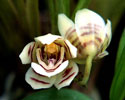|
|
|
|
|
| |
Flasks of
Koellensteinia graminea 'MC838' × self |
|
| |
|
|
| |
| Number: |
TN2033 |
| Name: |
Koellensteinia graminea 'MC838' × self
|
| Type: |
self (What's that?) |
|
Seed Donor: |
Dale Borders
|
|
Click to Enlarge

Pod Parent Flowers |
|
|
|
| |
Culture Notes from Donor: Parent plant: Temperature range I (60-83°F)
Comments: An easily grown species related to Zygopetalum.
For additional origin/habitat information supplied courtesy of
Charles and Margaret Baker, see further below, near the bottom of this page.
|
Temperatures we attempt to use in the lab & greenhouse:
| For Species: |
|
Spring, Summer, Autumn, Winter: days average 89°F, nights 70°F; best fit is Warm 90-70°F
(Source:
Baker's Web OSC) |
|
About the name...
| Etymology of |
graminea |
|
From Latin "gramineus" grass-like.
(Source:
Mayr & Schmucker 1998) |
| Pronunciation of |
graminea |
|
gra-MIN-ee-ah
(Source:
Hawkes 1978) |
|
If you would like to direct someone to this web page, please copy and paste this URL into your email:
http://troymeyers.com/d?012033
| Flask Information |
| Availability: |
Capsules failed. We were not able to make any flasks. |
| You should: |
Consider placing a "Notify Retries" Request, and if an identical pollination (the same parents) is done again, we'll let you know. |
|
You might also want to:
|
View items of the same species.
View items of the same genus.
|
| Ordering Information |
| You are not currently logged in. |
|
You must be a registered user and be logged in to reserve a flask or place a notification request. Please log in:
|
|
|
|
|
|
| |
The origin/habitat information below is supplied courtesy of Charles and Margaret Baker
The following information is based on the name of the plant provided by the donor, and assumes that the name is correct. If the plant has been misidentified, then the following information may not be correct.
This text is copyrighted by the Bakers and may not be reproduced without permission.
ORIGIN/HABITAT: The West Indies, Venezuela, Brazil, Colombia, Ecuador,
Peru, and Bolivia. Plants grow on trees in very wet forests at 250-2800
ft. (80-850 m). In Ecuador, this orchid is most common on the eastern
slopes of the Andes in the Provinces of Napo, Pastaza, Tungurahua, and
Morona-Santiago, but it is occasionally found in the northern Provinces of
Carchí and Esmeraldas. In Peru, plants grow near Iquitos in the Department
of Loreto at about 400 ft. (120 m). Collections in Venezuela were made
near Santa Teresa, in the southeastern part of the State of Bolívar, at
2450-2950 ft. (750-900 m).
More about this information and the Bakers...
|
|
|
| |
|
|
|